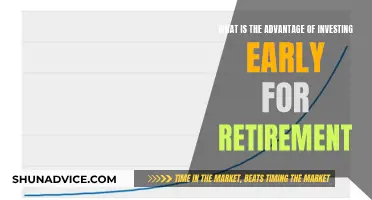
Smart people are investing in a variety of things, but there are some common principles that can be followed to be a smart investor. Firstly, it is important to start investing early and consistently. This allows your money to grow over time and benefit from compound interest. Diversification is another key principle, as it helps to manage risk and protect against financial losses. Smart investors also consider their risk appetite and financial goals, avoiding the herd mentality and making considered decisions. While there are many investment options available, some popular choices include stocks, bonds, property, gold, and retirement plans.
| Characteristics | Values |
|---|---|
| Start investing | As early as possible |
| Investment frequency | Consistently, at least once a month or quarter |
| Portfolio diversification | High |
| Risk appetite | High, but not too high |
| Investment types | Stocks, bonds, gold, real estate, retirement plans |
| Investment research | In-depth understanding of the company, its industry, and its competitors |
| Investment horizon | Long-term |
| Investment goals | Wealth creation, retirement planning, education funding |
| Investment monitoring | Regular, at least once a year |
What You'll Learn

Start investing early
Investing can be intimidating, and many people put it off because they think it is too complicated or risky. However, smart investors know that the longer you wait to start investing, the more you miss out on opportunities to grow your wealth. Starting early is one of the most important things you can do to build a substantial nest egg for the future. Here are several reasons why:
Compounding Interest
Compounding interest is a powerful tool for growing your wealth over time. It occurs when you reinvest the interest or gains you earn on an investment back into the same account, creating a cycle of gains. The earlier you start investing, the more time your money has to benefit from compounding interest. Even if you can only invest a small amount, the longer it is invested, the more it will grow.
Beating Inflation
The purchasing power of money decreases over time due to inflation. Money sitting in a savings account will lose value, and the interest earned on savings accounts will not even keep up with inflation for the most part. Investing allows you to outpace inflation and build wealth that will support you in the long term.
Higher Risk Tolerance
When you start investing early, you can afford to take more risks with your investments. As a young investor, you have time on your side, so if the market becomes volatile and your investments lose value, they are likely to recover over time. This means you can take advantage of riskier investments with higher potential returns, such as stocks, to accelerate your wealth accumulation.
Good Savings Habits
Starting to invest early helps establish good savings habits that will benefit you throughout your life. It also means that you will not have to contribute as much later on, as your money will have more time to grow.
Long-Term Growth
Historically, markets tend to grow over long periods, despite short-term ups and downs. By investing early, you can take advantage of this long-term growth and benefit from compounding returns.
In summary, starting to invest early is a smart financial decision that will pay off in the long run. It allows you to harness the power of compounding interest, beat inflation, take calculated risks, and establish good savings habits. The earlier you begin, the more time your money has to grow and the less you will have to contribute in the future.
Amazon: Worth Your Investment?
You may want to see also

Diversify your portfolio
Diversifying your portfolio is a key strategy for smart investors. By spreading your investments across a wide range of assets, you can reduce risk and increase potential returns over time. This strategy is often summed up as "don't put all your eggs in one basket".
The Covid-19 pandemic is a prime example of why diversification is important. Investors who had concentrated their money into one type of stock faced heavy losses compared to those who had diversified portfolios.
A diversified portfolio typically holds a combination of savings, income, and growth investments. For example, you could invest in stocks, bonds, gold, real estate, or retirement accounts. Each of these investments has its own risks and potential rewards, and by diversifying, you can protect yourself from heavy losses in any one area.
It's also important to diversify within each type of investment. For example, if you invest in stocks, it's wise to hold a variety of stocks in different companies and industries, rather than putting all your money into one company or one sector. This helps to further reduce risk and increase the potential for returns.
In addition to diversifying the types of investments you hold, it's also important to consider the level of risk associated with each investment. Higher-risk investments may offer the potential for greater rewards, but they can also lead to significant financial losses. As an investor, it's important to assess your own risk tolerance and choose investments that align with your comfort level.
By diversifying your portfolio, you can create a robust financial strategy that helps you build wealth over time, while also managing risk and protecting yourself from market volatility.
Investing: Nice People Turn Nasty
You may want to see also

Reinvest your returns
Reinvesting your returns is a great way to build wealth over time. When you receive returns on an investment, you can either pocket the cash or reinvest it to buy more shares or units of the same investment. This is known as a dividend reinvestment plan (DRIP).
DRIPs are a great way to reinvest your returns as they are automatic, flexible, and consistent. They are also cheap, as you won't owe any commissions or brokerage fees when buying more shares. DRIPs also allow you to buy fractional shares, which is not usually possible with brokers.
Reinvesting your returns can help you to supercharge your long-term returns due to the power of compounding. Your dividends buy more shares, which increases your dividend the next time, and so on. This is known as dollar-cost averaging (DCA).
For example, let's say you invest $20,000 in a company with a stock price of $20, so you end up with 1,000 shares. At the end of the first year, you receive a dividend payment of 50 cents per share, which comes out to $500. If you reinvest this dividend, you will buy 22.73 more shares (assuming a stock price of $22). At the end of the second year, your dividend payment will be $562.50, and you will be able to buy 23.24 more shares. After just three years of reinvesting your dividends, your investment will have grown from 1,000 shares to 1,069.55 shares, and the value of your investment will have increased from $20,000 to $28,471.
However, reinvesting your returns may not always be the right choice. There are a few situations in which it may be better to take the cash instead of reinvesting your returns:
- If you are at or near retirement and need the income.
- If the underlying asset is performing poorly.
- If you want to diversify your portfolio.
- If reinvesting unbalances your portfolio, for example, if you are overweighted in a few investments and they don't perform well, you could lose more than if your portfolio was more balanced.
When deciding whether to reinvest your returns or take the cash, it is important to consider your financial goals and risk tolerance. It may be helpful to consult a trusted financial advisor.
Stash Investing: Millions of Users
You may want to see also

Avoid high-risk, high-return investments
Smart investors are those who don't wait too long to start investing, as the longer your money sits in a savings account, the less purchasing power it will have. However, it's important to be cautious when investing, especially when it comes to high-risk, high-return investments. Here are some reasons why smart people avoid such investments:
High Risk of Losing Money
High-risk investments may offer the chance of higher returns, but they put your money at a much greater risk. While there is a possibility of high returns if things go well, the chance of things going badly is also higher. In fact, you could lose all of your invested money, and even end up owing money in some cases.
No Direct Relationship Between Risk and Reward
There is no guarantee that taking a risk will result in a reward. Sometimes, despite taking on high risk, investors may not receive any significant returns or may even lose money.
Unsuitable for Most Investors
High-risk investments are only suitable for a small minority of experienced investors who fully understand the risks involved and have the financial capacity to absorb potential losses. These investments are not meant for beginners or those who cannot afford to lose their money.
Lower Liquidity
High-risk investments typically offer lower liquidity, making it more difficult to access your money, especially if the investment is not performing well. Getting your money out may involve additional fees or penalties.
Volatility and Market Confidence Dependence
The value of high-risk investments tends to be highly dependent on market confidence, which can fluctuate significantly from day to day. Investor sentiment can be fragile, especially during economic uncertainty, leading to more volatile investment values.
Lack of Regulatory Protection
Many high-risk investments, such as commodities, student accommodation, and crypto, are not regulated by financial authorities. This means that if things go wrong, investors may not have access to regulatory protection or compensation schemes.
High-Risk Alternatives
Instead of opting for very high-risk investments, smart investors often look for alternatives that offer a better balance between risk and return. This may involve diversifying their portfolios across a range of mainstream investments, such as stocks, bonds, and real estate.
In conclusion, while high-risk, high-return investments may seem appealing, they are generally avoided by smart investors due to the disproportionate level of risk involved. It is crucial to thoroughly understand the risks and have the financial capacity to absorb potential losses before considering such investments.
Young Investors: Who and How Many?
You may want to see also

Understand your risk appetite
Understanding your risk appetite is a crucial step in making smart investments. It refers to the amount of risk you are willing to take to achieve your financial objectives. This involves setting an upper limit on the risk you are comfortable with and a lower limit on how much risk you are willing to take. For instance, a highly regulated business like a nationalised utility company will generally have a lower risk appetite. On the other hand, a company with a strong culture of innovation, such as a software development firm, may have a higher risk appetite to achieve customer growth.
Your risk appetite will depend on several factors, including your industry, company culture, competitors, nature of objectives, and financial strength. For example, if your objectives are aggressive, you may be willing to take on more risk. Additionally, the more resources your company possesses, the higher its risk appetite is likely to be. It's important to periodically assess your risk appetite, as it can change over time due to changing circumstances, available resources, and evolving skills and technologies.
To effectively manage your risk appetite, you should establish key risk indicators (KRIs) that look forward and provide early warnings of potential threats or opportunities. These KRIs should be regularly updated to provide a 'live' picture of the changing risk landscape. Additionally, it's crucial to involve senior leaders and executives in setting the tone for risk-taking and ensuring their buy-in for your risk appetite framework.
By understanding your risk appetite, you can make more informed investment decisions. For example, you might decide to invest in stocks or shares of great companies, real estate, gold, or bonds. Each of these investment options has its own set of pros and cons, and your risk appetite will help guide you in choosing the right ones for your financial goals.
XRP Investors: How Many?
You may want to see also
Frequently asked questions
Smart investing can help you create an additional source of income, provide long-term financial security, and create sufficient post-retirement wealth.
Start investing early, make consistent investments, build a diverse portfolio, and don't underestimate the power of compound interest.
Not investing early enough, investing sporadically, not diversifying their portfolio, and chasing high-return investments without considering the risks.
Review your investment portfolio at least once a year to ensure it aligns with your financial goals and risk tolerance. Make adjustments as needed based on market conditions, life events, and changing goals.







